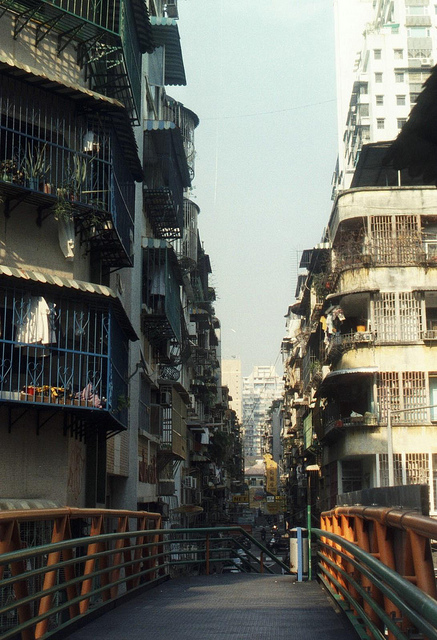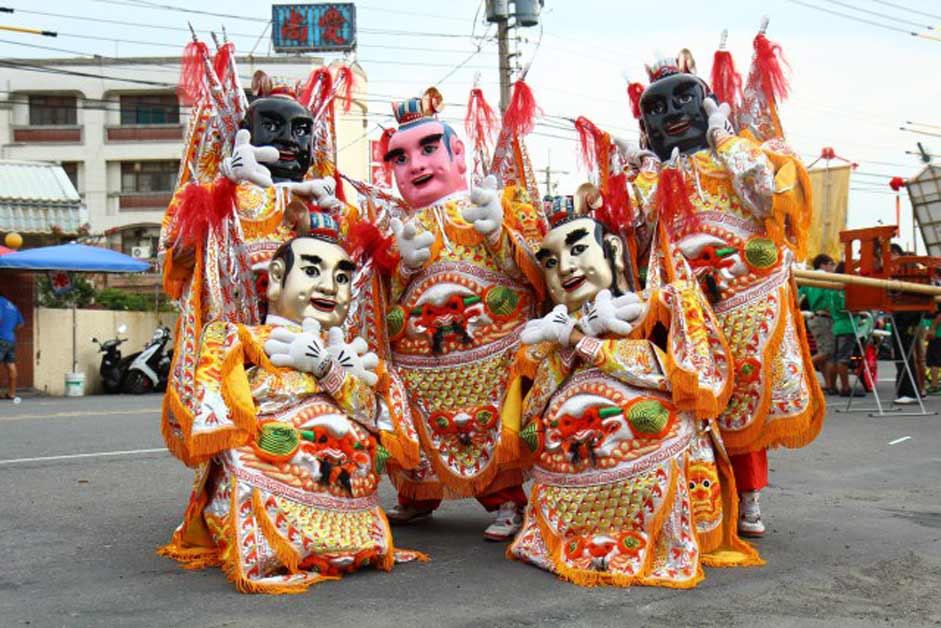Cultural and Creative Industry
Ten Iconic Cultural Features of Taiwan?

Source:Kuo Tai Liu
Night markets, scooters, the indigenous...what can best represent our culture? How do young Taiwanese react to this question? When political ideologies have been drawing "the line" clearer and clearer, is cultural identity becoming more and more uncertain?
Views
Ten Iconic Cultural Features of Taiwan?
By Mark Linweb only
Since I’ve returned from the United States to Taiwan for my teaching and designing career, I often ask my young friends during a lecture or class, (who are mostly “cultural and creative design-specialized” students), “What are some examples of iconic cultural features of Taiwan?”
I’ve hereby listed the ten most common answers, along with my comments and personal opinion, by which I hope may inspire more thoughts and deeper discussion.
#1 Betel Nut Beauties
“Give me one example of an iconic cultural feature of Taiwan.”
“Betel nut beauties!” (answered a girl)
“Are you a betel nut beauty? Or are you looking into becoming one?”
“Are you kidding me? Of course not!”
So this cultural feature is a profession this girl is neither interested in, nor willing to engage in.
#2 Iron-Grated Windows
“Give me one example of an iconic cultural feature of Taiwan.”
“Iron-grated windows!”
“Are they beautiful?”
“Not at all, and they make the city look like a mess. But this is unique.”
Makes sense. No matter how they look, “uniqueness” lies in the eye of the beholder. It’s just about whether others can take it or not.
But many iron-grated windows can also be spotted in Macau, though.

Iron-grated windows in Macau (Image: Flicker@Sarah Joy)
#3 The Indigenous
“Give me one example of an iconic cultural feature of Taiwan.”
“The Indigenous!”
“Are you indigenous? Or do you speak their language, wear their clothes?”
“No. Never had. But I’d be willing to.”
If you identify something as an iconic cultural feature, shouldn’t it be at least relative to the everyday life of most people of this culture? The indigenous culture in Taiwan is a treasure worth to be valued, protected, and promoted. But after all, most of what we eat, what we wear and what we say today, are not from these native islanders.
They are part of Taiwan. They once owned the island. We should genuinely pay respect to this part of history and to their culture heritage. Yet today when most Taiwanese are not indigenous, can their culture represent Taiwan? This is worth thinking about.
In the United States, there are Indians; In Australia, the Maoris; In Yunnan China, the Miao, and there are many other native communities in other places in the world, whose culture has its value but might not necessarily be considered an iconic feature that can represent the country.
#4 Nezha Deity and Din-Tao
“Give me one example of an iconic cultural feature of Taiwan.”
“The Nezha deity and din-tao.” (Din-tao 陣頭:The Parade of Taiwanese Deities.)
“Din-tao is a Taoist ritual. Do you know much about Taoism?”
“I guess so. The Supreme Old Lord, the Jade Emperor, Guan Yu, and Guanyin. It’s about those gods, isn’t it?”
“The Supreme Old Lord” is in fact the religious name of the Taoist philosopher Laozi. His philosophy can be traced back to “I-Ching,” or the Classic of Changes, a book about how Nature changes, and how humanity should conform with it. I-Ching was said to be written by Fuxi, the dawn-ancestor who cradled the Chinese race.
As a matter of fact, such folk rituals like din-tao have long drifted away from its origin, the principles of I-Ching. In such case, to truly understand the meaning of din-tao, the eyes of a “cultural and creative designer” should see deeper into the aesthetic and essential aspect beneath "the representation of this religion".
 Dancing Nezhas with Micky Mouse Hands (Image: Mark Lin)
Dancing Nezhas with Micky Mouse Hands (Image: Mark Lin)
#5 Tai-Ke
“Give me one example of an iconic cultural feature of Taiwan.”
“…Tai-Ke,” answered an “arty hipster” with black-framed glasses. (Translator’s note: "Tai-ke" may refer to a typical Taiwanese “redneck” or anyone who emulates the déclassé lifestyle, such as, by wearing flip-flops or smoking long-life cigarettes.)
“What songs do you like?”
“Post-rock and EDM, like Radiohead, and Armin Van Buuren.”
“What about Jeannie Hsieh?”
“Well…”
When an “arty hipster,” who shows not the least trace of a déclassé Taiwanese style, thinks of the“tai-ke” style as an iconic cultural feature of Taiwan just because its “so in trend now,” how is he different from a man who says “I love you” to his wife while having other women out there? Both are beautified lies.
“Then…blue-and-white flip flops? Or red-and-white plastic bags?” (suggested the arty hipster.)
“Would you wear blue-and-white flip flops or bring red-and-white plastic bags to meet your date?”
“…I’s say I wouldn’t.”
When we’re talking about the cultural and creative industry, an iconic cultural feature should be something that can be put on the global stage, something that can stand out for us, not just represent us. Besides, these flip flops and plastic bags belong to the memory of the locals. Features of such are only celebrated here. You can’t profit from it elsewhere.
#6 Friendliness
“Give me one example of an iconic cultural feature of Taiwan.”
“Friendliness!”
“What are some concrete examples of “Taiwanese friendliness”?”
“Hmm…Buy one get one free in traditional markets?”
“Taiwanese friendliness” is a vague term. Can anyone clearly define “Taiwanese friendliness” as a cultural feature?
Besides, how does “Taiwanese friendliness” differ from “Hong Kong friendliness,” or the “American friendliness?”
If this undefined “friendliness” is the only word we can think of as a synonym of our culture, then all discussions about culture and creativity designs are nothing but a waste of time. If we ourselves fail to understand our own culture, how could we apply it to the creative industry?
(Read: Being Friendly is Not Enough)
The culture is the pearl of a group of living experiences. It should be hidden in our everyday lives. There must be something from a living-in-Taiwan experience that can’t be offered from other places, and there must be a more concrete explanation for it than “Taiwanese are friendly.” We just haven’t found it yet.
#7 Little Happiness in Hand
“Give me one example of an iconic cultural feature of Taiwan.”
“Those little happiness in hand—little, but in hand.”
“That expression coined by the Japanese writer Haruki Murakami?”
“Yes.”
“Little happiness” is a lighter word for “blessing,” when “blessings” become too much to ask for.
“The little happiness in hand” is the pleasant moments of everyday life that can be found only with a detail-attentive mind. As a concept introduced by a “Yamato,” it is pretty convincing. Yamatos are known for being extremely cautious about details. They find pleasure in slicing off a piece of Sashimi with precision.
Yet, for most Taiwanese, “little happiness” is more like a consolation. At a time of low income growth, people relieve themselves from their struggles by buying these “healing” toys and “small creations” that are designed to offer these “little satisfactions” of life.
So is this “little happiness trend” a form of culture originated in Taiwan, or is it a result of our current situation? No matter which, using a translated term, originally coined by a Japanese, to refer to a cultural feature of Taiwan, is by all means an act of surrender in the first place.
#8 Scooters
“Give me one example of an iconic cultural feature of Taiwan.”
“Motor scooters?”
Scooters, streaming through the traffic, parked besides the roads, are probably the first impression many foreigners have about Taipei. Indeed, Taiwan has the highest density of scooters in the world. Yet, this “unique” first impression often becomes a negative one when they find these scooters everywhere, blocking sidewalks, weaving through the traffic, emitting noise and pollution (cars do too), degrading the cityscape.
There is in fact a sound system of public transportation in Taipei, but with a scooter one can save a bit more walking. Since many people have scooters, few people protest to the cost it brings. For many Taiwanese, the need of convenience overweighs the need of a pleasant cityscape.
Yet, speaking of convenience, impressively well-rounded services offered by convenient stores, incredibly easy access to taxis, and the widespread use of EasyCards, Ubike…etc are all features of this “culture of convenience.” Perhaps when it comes to cultural and creative innovations and design, thinking about how to visualize and productize these features may be a good place to start.
(Read: Can Taiwan Transition to Electric Scooters?)
#9 Tea
“Give me one example of an iconic cultural feature of Taiwan.”
“Tea!”
“Are there more Tea shops around in Taiwan than cafes?”
“There are a lot of tea shops out there, like Kingyo, Gong Cha, Ten Ren’s Tea, and the tea street in the East District, aren’t there?”
Taiwanese tea is good to drink, and there are indeed many tea shops in Taiwan. This may prove that there is nice tea in Taiwan, but a distinct “tea culture?” Probably not, or not yet. Compared to many cafes in Taiwan, tea shops still have a long way to go when it comes to creating a distinctive ambience and shaping a tea-drinking culture.
Tea ceremonies in Japan ritualize the Japanese tea culture and demonstrate its refinement through an exquisite choice of instruments, the script, the clothing, the ornaments, and the plantation and decoration of the garden. By comparison, the development of Taiwanese tea culture is still in a rather preliminary stage.
Yet there is potential. The most distinctive feature of Taiwanese tea drinks lies in “a blend of flavors.” Bubble milk tea, plum green tea, lemon black tea, grape fruit green tea…etc, all these beautiful mixes are proof that a twist on classic tea drinks can offer a promising outlook. Try different combinations with more natural ingredients, bring more choices to the menu, and give the tea shop a classic-modern design, perhaps with some in-season plants to embellish the ambience. How to optimize the potential of Taiwanese tea culture is worth thinking about.
(Read: Taiwan Tea in Starbucks)
#10 Night Markets
“Give me one example of an iconic cultural feature of Taiwan.”
“Night markets!”
“What do you think about the food there? Delicious? Healthy? Clean?”
I must remind you that night market stalls are unfortunately the most iconic victims of food scandals.
There are plenty of night markets in Taiwan, most of which still have much room for improvement regarding its sanitary condition, food quality, and placemaking.
 (Image: Mark Lin)
(Image: Mark Lin)
Yet night markets are celebrated for its delicious, budget-friendly, and widely-diversified foods. These are in fact features that can be polished and promoted.
Keeping the foods budget-friendly and delicious to keep them a bon marché, or in other words, keeping this cost-based pricing strategy, is a typical “habit” for the people who have been long used to doing OEM for others. Thinking about how to convert this “habit” into a more value-based strategic thinking focusing on the essential, the aesthetic, and the functional aspect of the products, is just the same as finding the solution to the many problems Taiwan is facing during its OEM-to-brand transformation. So, how? Night markets have given us another clue—its “wide-diversity” in foods.
Imagine a dining table of a typical Chinese family. Isn’t it loaded with a wide variety of dishes? This suggests how diversification is embedded in our food culture. We like our foods “diversified,” and we keep “diversifying” our foods. Surprisingly, this preference can be traced back to the philosophy of change, or I-Ching, as I mentioned.
My sharp comments are not to belittle the culture of Taiwan, but to inspire new ideas on the development of the cultural and creative industry. I encourage my students to identify the representation of our culture, to extract the essence within through historical thinking and imagination, then finally to use creativity to visualize this cultural essence and give our culture a new look.
Representing a culture with creativity, isn’t that exactly what cultural and creative industries should be upholding? Identify the phenomenon (like the foods in night markets), find what’s embedded within (like wide diversity), and transform it into a cultural icon or a brand. It is something worth thinking about and acting on, isn’t it?
Cultural and creative products are not a fraud. They are not easy money, especially in a land that is not the hearth of its own culture, historically or geographically speaking. In a place where cultural identity has become more and more uncertain as ideologies have being drawing the line clearer and clearer, “cultural and creative” becomes a rather empty adjective, and can easily be defamed as a fraud.
What are our cultural features? Which are presentable to others? Which are strengths and which are weaknesses? We have to clearly distinguish them, and think about how to turn the weaknesses into strengths. That takes creativity, and wisdom.
Be faithful to your culture. Think about its essence. Dive deeper into it, extend it, and represent it. I believe that the day will come when everyone can answer this “What are some iconic cultural features of Taiwan” question with one simple sentence, and most importantly, with confidence.
Translated by Sharon Tseng.
The original Chinese article can be found here.

Crossing features more than 200 (still increasing) Taiwanese new generation from over 110 cities around the globe. They have no fancy rhetoric and sophisticated knowledge, just genuine views and sincere narratives. They are simply our friends who happen to stay abroad, generously and naturally sharing their stories, experience and perspectives. See also CrossingNYC.
Additional Reading
♦ Chatime: Pearl Milk Tea Craze Sweeps the Maldives
♦ Tainan City: Taiwan's New Cultural and Creative Mecca
♦ A Home, A Factory, A Microcosm of Taiwan’s Economy







